March marks the time of year when gardening turns serious !
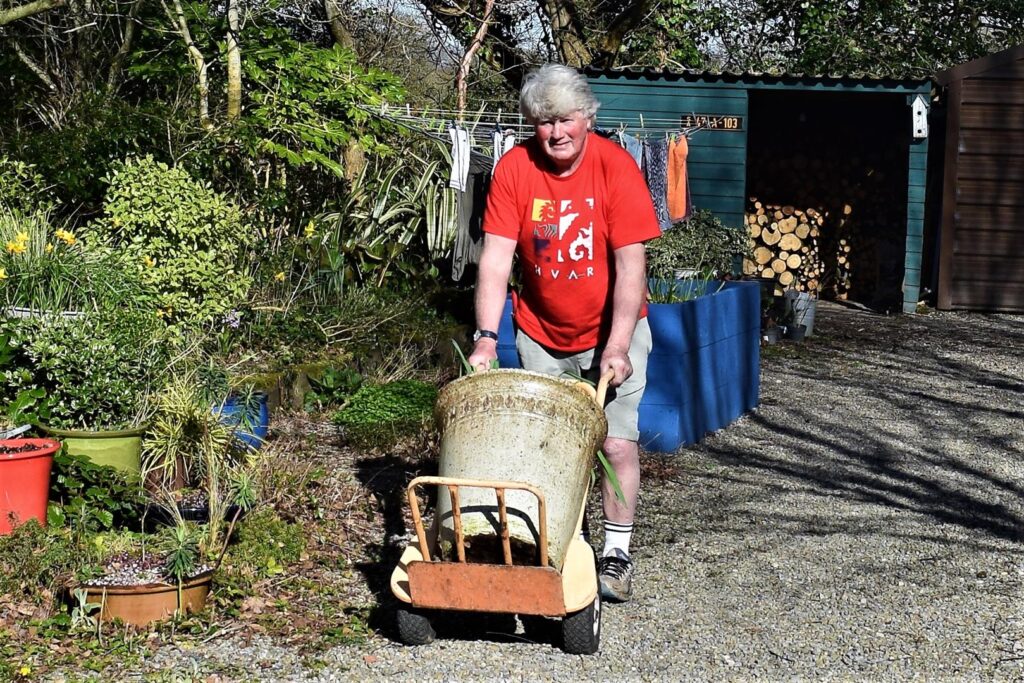
That extra hour of daylight , new growth beginning in perennials , trees and shrubs with daffodils and tulips in full bloom and beads of sweat on the forehead as the wheel barrow is taken out of storage , the effing and blinding when you try to start the mower for the first time since last October !
During March I added to the new water area planting at a furious rate adding cuttings of houtania along the wet edges and geranium slips in the drier banks for ground cover and then adding a path of concrete paving slabs through the new planting as a final touches and we also added four new pots to our collection .
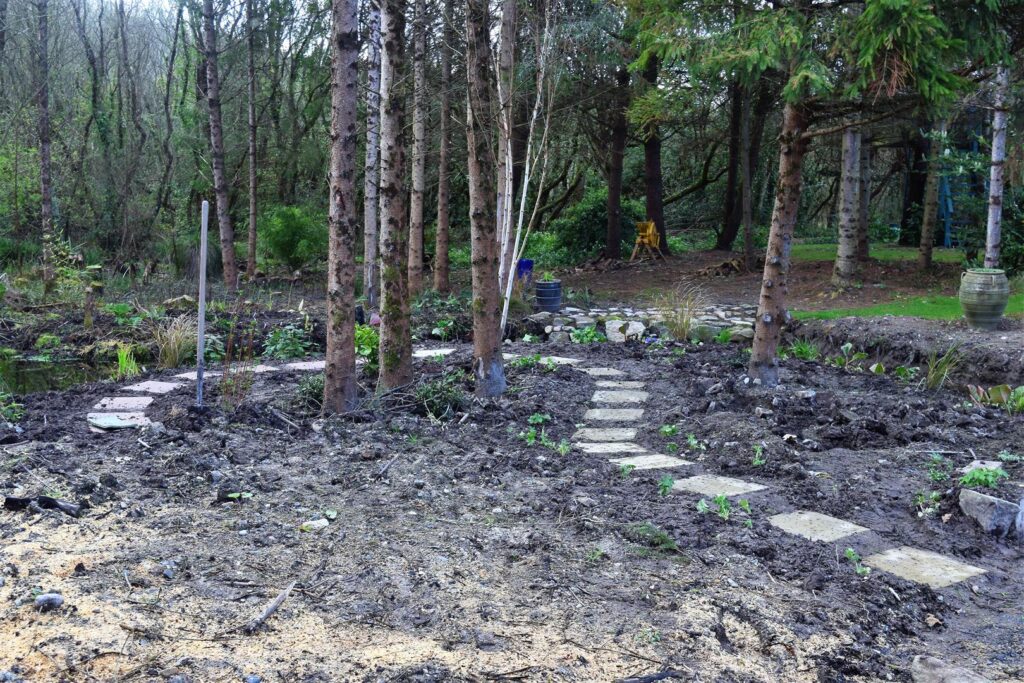
My winter reading regime always includes gardening books and collections of articles by my favourite gardening authors .The two gardeners whose writings I love are Dan Pearson and Monty Don and their own personal gardening philosophy and style of wild informal gardening also appeals to me . I have all their books and collections of garden articles they have published over the years as gardening correspondents for the UK Independent and Observer newspapers and not only are they great reads with a mine of information but both come across as really nice people . Monty Don is of course a regular on TV with Gardener’s World on BBC 2 and also presents the Chelsea Flower Show Week so is the better known of the two and he also is a prolific writer who publishes almost a book a year however Dan Pearson would be the gardener’s gardener and publishes a book every four of five years .
I enjoy both as writers but I get the impression that Monty Don’s once a year books are written and published because he is commercially in demand and his books sell spectacularly well whereas Dan Pearson’s books are about subjects close to his heart , are deeply personal and would be more appealing for the long haul gardener. That said , Monty Don relies on his writings and TV appearances for his living whereas Dan Pearson , a Chelsea Gold Medal winner , is in demand all over the world as a designer of huge garden projects . Monty Don and Dan Pearson are two unique gardeners , not shouty or showy off and both have a sincerity and a gentle approach and while I enjoy Monty Don’s articles better but find that Dan Pearson’s books , especially the two where he describes building his own two gardens , are for the long read and are books I come back to again and again .
Three garden writers I also come back to time and time again are Robin Lane Fox , Christopher Llyod and our own Helen Dillon … I would suggest if you want just five garden books on your shelf these are what I would choose , the Well Tempered Gardener by Christopher Llyod , Better Gardening by Robin Lane Fox , Home Ground Sanctuary in the City by Dan Pearson , The Complete Gardener by Monty Don , Garden by Helen Dillon .
We have used the past five months months of Covid lock down to do a complete overhaul of the conifer and willow trees in the garden and this month we managed to get the last of the major cutting back done along with two huge conifers that came down in the recent winds with the result that both wood sheds are full and there has been a major opening up of views right across the various areas … a hard slog with every muscle aching or perhaps that is just old age ?!
A big debate across all the web garden forums is hostas and how to protect them against slugs and my view is quite definite on that subject … slug pellets and lots of them to protect the emerging hosta tips at the beginning of April … but what is rarely mentioned is just how large hosta roots are in pots and we have a beautiful specimen of the large green leafed hosta Elegans that burst it’s container back in December 2013 and now eight years later it has broken it’s successor also this February . The answer of course is to regularly dig out the hosta every three or four years , dividing and replant a section leaving you with at least three other sections to plant elsewhere however in this particular example the hosta is so beautiful and healthy I have never had the heart to disturb it but enough is enough and I am drawing the line at a third pot being broken .
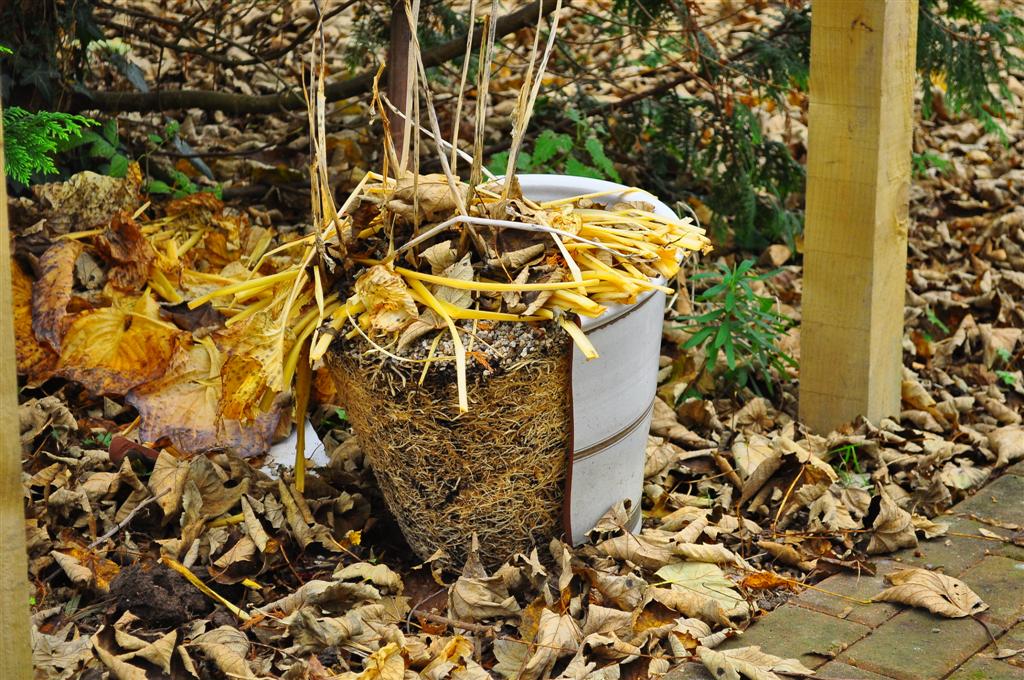
I dug out the hosta from the cracked pot and took the spade to it and cut it into two pieces , it was large enough to cut into four sections but to be honest I have loved that big leafed hosta elegans for twelve years now and don’t want to wait around for a year for the new plant to fill out in it’s place in a shaded corner of the front garden and the replanted half will be a decent enough size this year while giving me a second hosta to go into a new pot .
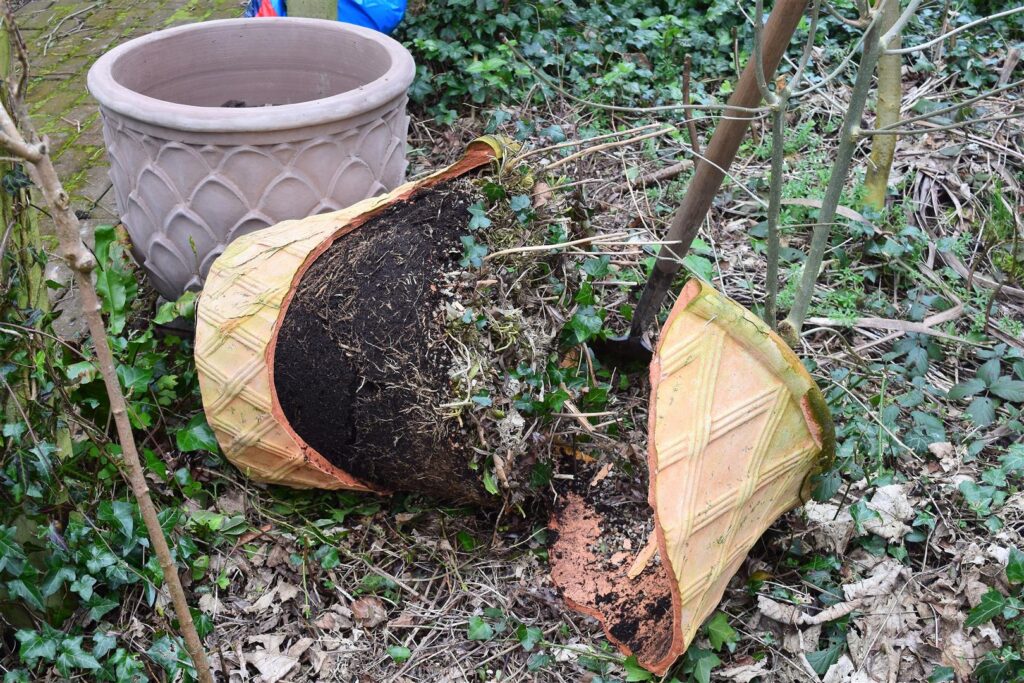
So next day we took ourselves up to Clonmel Garden Centre to source a replacement pot for the oversized hosta where Snezana promptly fell in love with not one but three beautiful pots which will be a great addition to the garden and one of these will provide a home for the divided hosta while the other two , a matching pair in terracotta with a blue ceramic veneer . The pots are large statement types and can easily stand alone however having walked them around different locations close to the house we decided to replace a pair of pots at the entrance to the outdoor steps at the back door which have been there since last summer only … and that worked and put the new pots directly in view from the kitchen . The pots were filled with my usual mix after first having lined the base with large stones and bits of broken crockery to help drainage … ordinary garden earth mixed with coffee grounds and topped with John Innes potting compost and finally topped out with pea gravel for decoration .

The next decision is what to plant in the pots , their position will be in full sun all day , a bit exposed to wind also and as they are in full view a few feet from the kitchen window I have gone for an all year display , a mix of evergreen perennials with a low growing silver grass and a rambling variegated vinca and perhaps one hellebore in each pot which will be topped up with seasonal flowers such as bedding annuals for late Spring and Summer and petunias in Winter so that there is always something to look at .
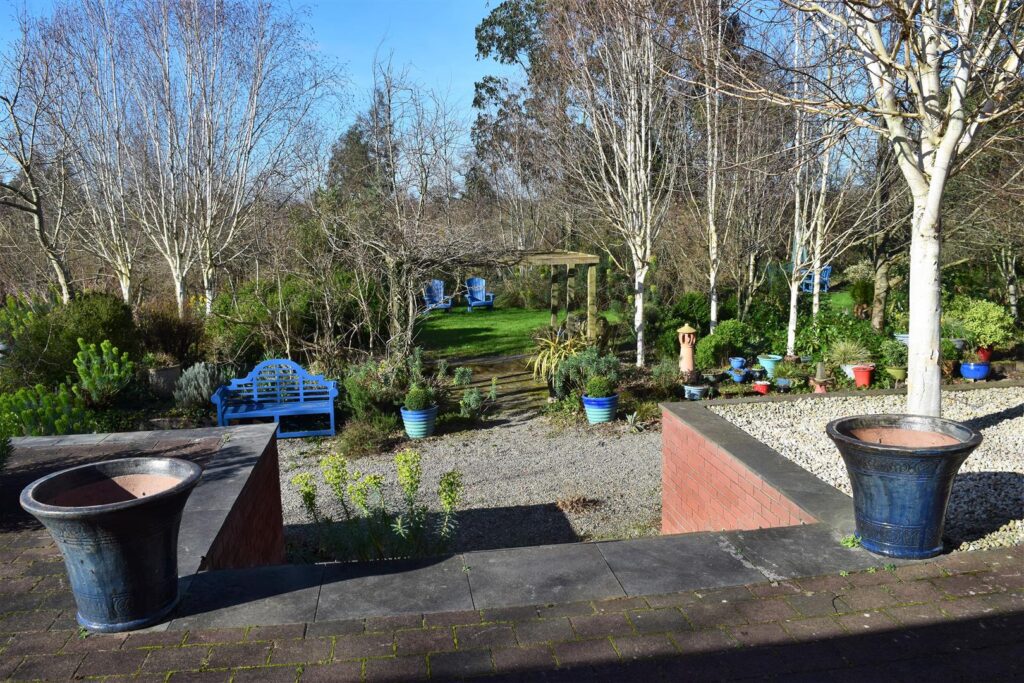
I am always on about protecting hostas from slugs and my views are well known , surround the growing tips with the little blue slug pellets when they first show above ground in the first week of April and top up at least once after five weeks . I know of no professional gardener who doesen’t use slug pellets and yes I have heard and read about all the more organic methods such as layering the pot with garlic , broken glass , leaving out beer in saucers for the slugs and then gathering the tipsy little buggers up and removing them … none of these work by the way ! Anyway just to show you how cunning slugs are , today I moved the cracked pot in order to remove the huge hosta and under the pot guess how many slugs I found over wintering and just waiting for hosta season … 32 sleeping slugs in shells and even one slug will reduce a healthy hosta to a few pieces of leaf and hostas never regrow in the same season so you have lost a full season so you can imagine what 32 slugs will do .
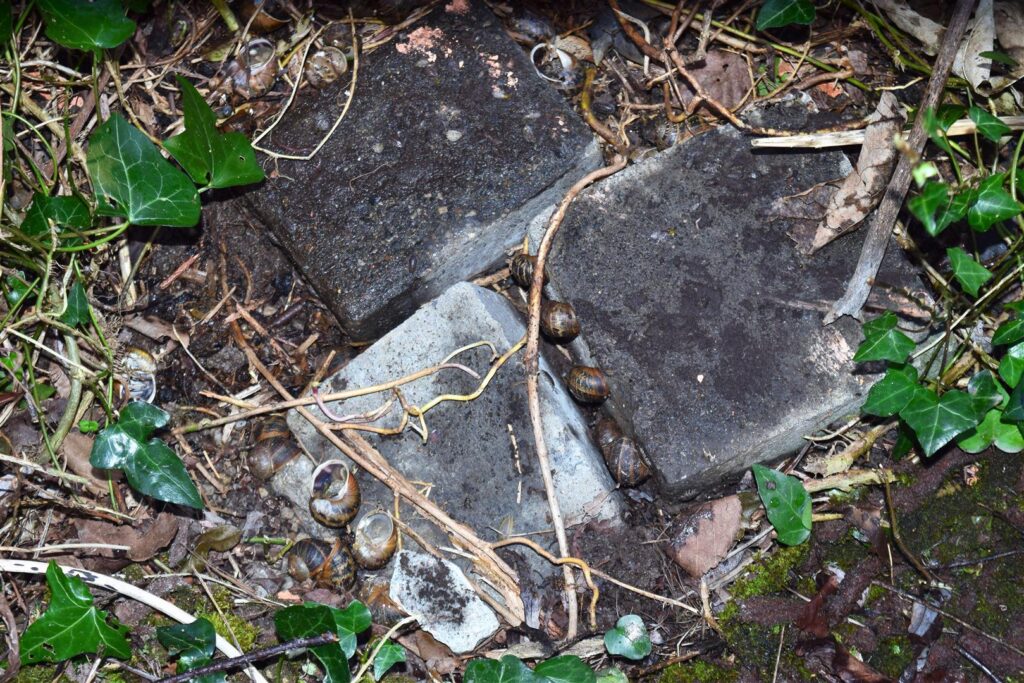
I know all you tree huggers out there are anxious to find out what I did with the slugs well I have mentioned before that I have a French neighbour haven’t I … and you do know what French people do with snails … fried with some garlic and creme fraiche , yum yum ?!!
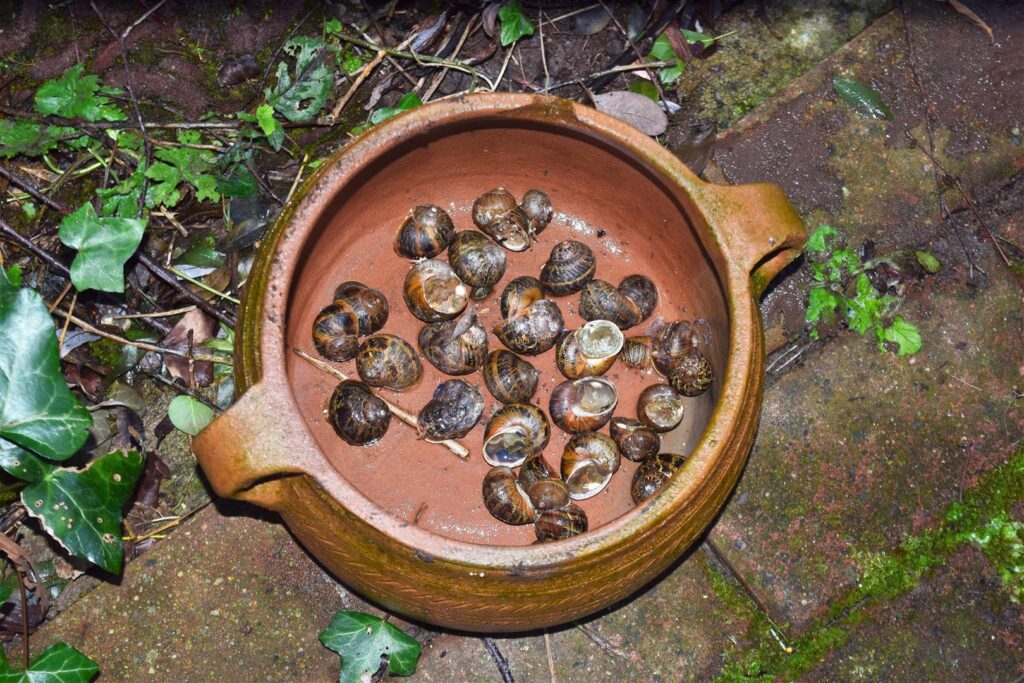
The morning after I wrote the above on slugs I was watching Dr. Guy Barter , Chief Agricultural Officer of the Royal Horticultural Society being interviewed on the BBC about a news item that the RHS had classed the garden snail as the No. 1 Pest in the garden according to reader’s complaints during the past year of Covid . Nothing new there you might say but I almost fell out of my chair when Dr. Barter went on to say about the slug problem “ you have to be reasonable and if snails and slugs are a real problem in the garden then it is fine to use slug pellets ” .
Thank you Dr. Barter , you made my day !!
Extracts from my Montenegro Diary January 1996 during the Bosnian War .
When I first arrived at the Vellusi border crossing one of the first things explained as part of our duties was a daily trek back down the road towards Niksic where there was a small by pass track / road by which if you were a local farmer with land on both sides of the border you could yes by pass the official border crossing – if you had a mind to do so and it is a given that everybody in these times has an intention to by pass the official crossing . The ICFY Mission had erected a barrier across the road which could be raised and lowered and which was kept sealed at all times – nevertheless although never proved it was always the suspicion that somehow the smugglers were getting though the barrier with vehicles and of course they always knew from the interperters and drivers where the ICFY patrols were each day – yes we filed them beforehand with the local police as part of the EU agreement with Milosovic – some control ! This day when I went to inspect the seal unlike previous days it was snowing and there on the ground going though the barrier was a set of heavy tyre tracks yet the seal was intact – I double checked it as it could have been slipped off and stuck back on loosely – it was OK – I KNEW IT WASEN’T OK AS THE FUCKING TYRE TRACKS WERE THERE AND THE TRUCK DIDN’T LIMBO DANCE UNDER THE BARRIER … I triple checked the seal and then had a good look at the barrier post cemented into the ground and while lifting the other end of the barrier the whole installation came out of the ground effortlessly – the smuggling mafia had cut around the cement holding the post and this was now operating like a swing gate ! Great detection Sherlock and I should have legged it back to the radio and reported it but no , Cuchulainn that I am I HAD to walk down the track following the tracks and the increasing number of foot prints and fuel barrel prints appearing in the snow along with the vehicle – farther and farther I went deep into the forest and high on the mountain side down I could see the customs post which meant I was now in Bosnia – again reality check time , HELLO – did I stop no and rounding a corner in the rapidly decreasing January evening light I walked into a clearing in the trees which was full of extremely large hairy macho gold medallion men , armed to the teeth and surrounded by a huge amount of fuel barrels — they saw me immediately and all straightened up from the barrels cutting out what little light was available – perhaps in some foolish recess of my mind now rapidly turning to mush I probably clung to the hope that they might panic and scatter into the woods – some hope as these were their woods , their fuel and best of all THEIR AK47’s so next move Horatio — I kept walking as to run back now as all my survival instincts were screaming at me would mean a general charge after me — and so I came up to the main group to whom I gaily waved and hailed with DOBER DAN CA COS DE , HELLO HOW ARE YOU IN Serbian as I walked on past further into Bosnia – DOBER DAN THEY ALL SAID BACK TO ME CA COS DE VI hello and how are you ? DOBER I SAYS HVALA LEPO VREME SUPER , great thank you for asking , the weather is great … it was a surreal moment and extremely dangerous .
Suffice to say we were all shocked at what had just happened … they that any EU enforcement official was lunatic enough to walk into Bosnia during the war … and me stunned that I had wandered into a major oil smuggling operation alone and armed with just my little EU official overcoat .
WHAT THE F..K TO DO NOW THOUGH ?!
After another 500 metres I decided I would be totally lost if I continued so I headed back the way I came , the group was now twice as big as it was and the rest had probably been watching me from the trees – another chorus of DOBER FUCKING DANS on all sides and I made it around the next corner out of sight from where I broke all known Montenigrin sprint records for the next 3 Km back to the customs post !!!!
Yes it was a major detection and I got away with it … I still have nighmares about it though .
Colour in the garden in March
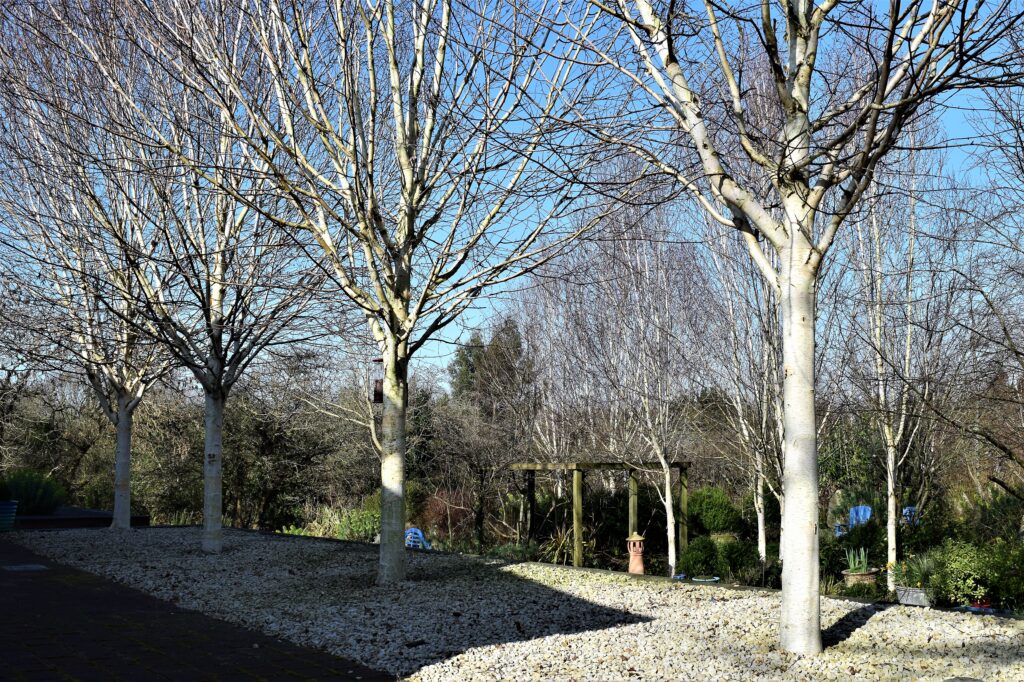

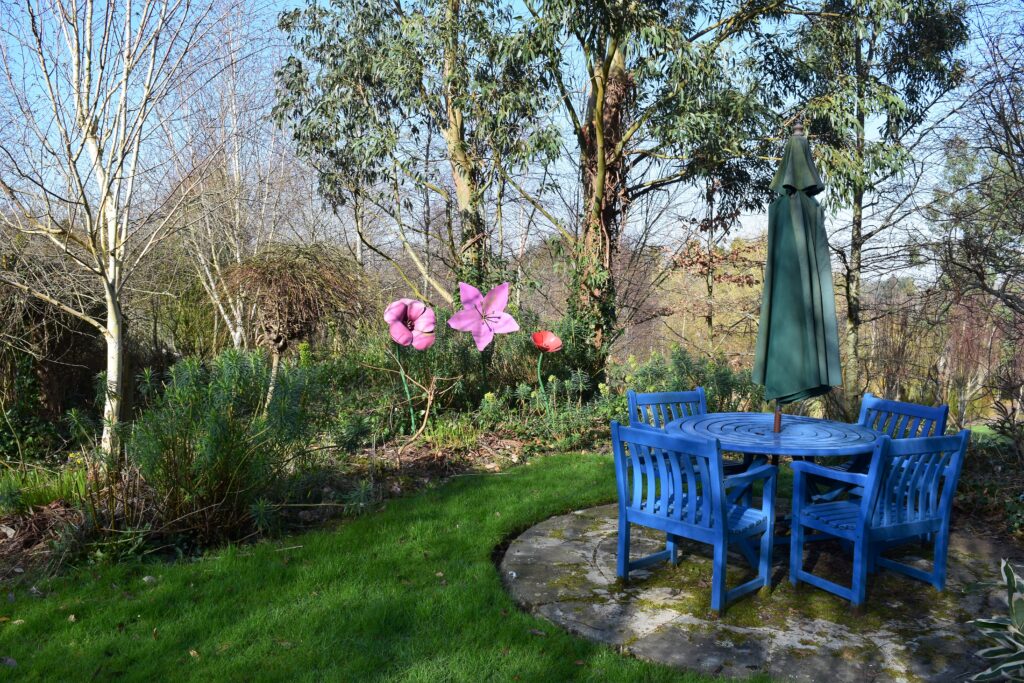
Gardening people , myself included , bang on about the classic trees and shrubs and the joy they undoubtedly bring but for me it is the unsung heroes that when you chance upon them especially in the winter garden can lift you and such a plant is the humble pulmonaria .
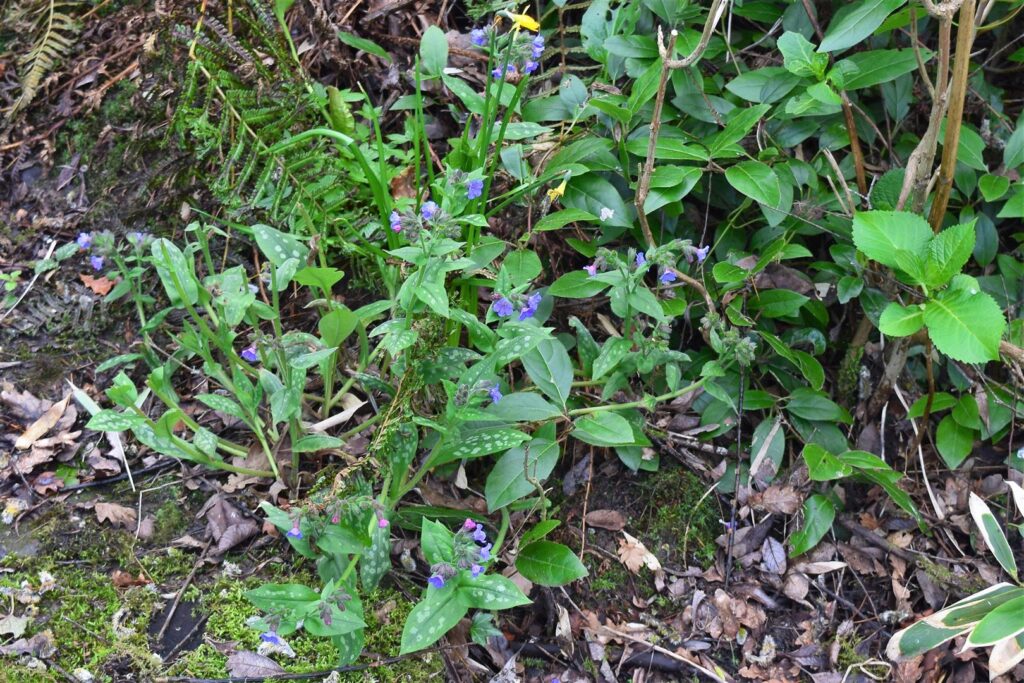
Garden design at it’s purest level is all about setting out in advance your plan on paper , assessing the site orientation for sun light , taking into account the soil you have whether it is wet or dry , in sun or shade and this will largely determine what trees , shrubs or plants you can accommodate on a right plant right place basis and there is a third category which I loosely categorise as what the f..k we’ll chance it !
And sometimes whatever your nice plans are for the garden your eventual design and choice of plans are dictated by the drawbacks of the site and this was certainly the case in this garden fifteen years ago when we started to examine the possibilities for the eight acres of wet rushy fields we had taken on and basically we adopted a policy of letting the design be dictated by the terrain … so where the garden was just water logged or under water we put the paths around these areas or in the case where the water was just too deep we put in wooden walk ways on two meter larch poles and bridged the problem places while trees and shrubs were planted where the soil was good and eventually we arrived where we are today with most of the eight acres in use .
This principle was used this week on the bank of the new water area where I hit a seam of pure marl a metre wide , a layer of mud like concrete where nothing could be planted and it was good only as the base for a small path so I laid paving slabs along it’s length of twenty four metres metres curving it through two conifers to the bank of the new wild pond and as it curves beyond the conifers it does add a certain air of mystery giving the illusion that it goes on an on and this illusion is essentially the magic of gardening encouraging the visitor that you are in the wild … perhaps even meeting the odd elephant such as this one we had an up close and personal encounter with in South Africa in December 2019 just before the Covid lockdown !


Pulmonaria officianalis is not a name that rolls often off the lips when discussing classic garden plants and as it likes moist soil in shade and flowers in winter it is not one that exactly rolls off the benches in the garden centres either but if you see it for sale grab it as it is an addition to any garden . We have two of them here , the common lungworth , has gorgeous blue flowers , variegated leaves and does it’s stuff without fail every year in a secluded shady part of the garden by the stream where it flowers away from December to March and never fails to bring a smile to my face when I happen upon it … not a plant for a prominent position but pulmonaria has no natural predators and comes back without fail every year and stuck away in an unsuspecting corner pulmonaria is a winner .
After almost forty years in gardening I have made it my business to learn the latin names of most plants and certainly those we grow here in Ireland and the UK and I very rarely if ever will refer to a plant by its “ common ” or local name which all plants have in every country but I have yet to see as many local names as pulmonaria has and if you google pulmonaria at the RHS web page you will see that it has over thirteen including , Jerusalem sage , Adam & Eve , Bedlam cowslip , beggars basket , bugloss cowslip , Jerusalem cowslip , Lady’s cowslip , Lady’s milk , Mary’s honeysuckle , Mary’s tears , Sage of Bethlehem , Soldiers & soldiers , Spotted dog , Virgin Mary’s honeysuckle … the latin name is easier to remember … yes ?!
Latin is the official language world wide for the names of plants . the linqua franca so to speak of the botanical world so that the same name applies to for example a pulmonaria in a Japanese garden as in an American garden instead of the local name .

My other half here doesen’t like hearing latin names for plants and considers it pretentious and although since coming home full time three years ago has mastered quite a few such as hellbores , hostas but still lapses at times into blue plant /white plant mode or her own pidgin version … yesterday we were passing the magnificent americanus lysichiton which is in it’s briefly flowering phase just now but it’s common name is the delightfully named American skunk cabbage which Snezana made a great effort at remembering but which came out as Canadian scumbag !
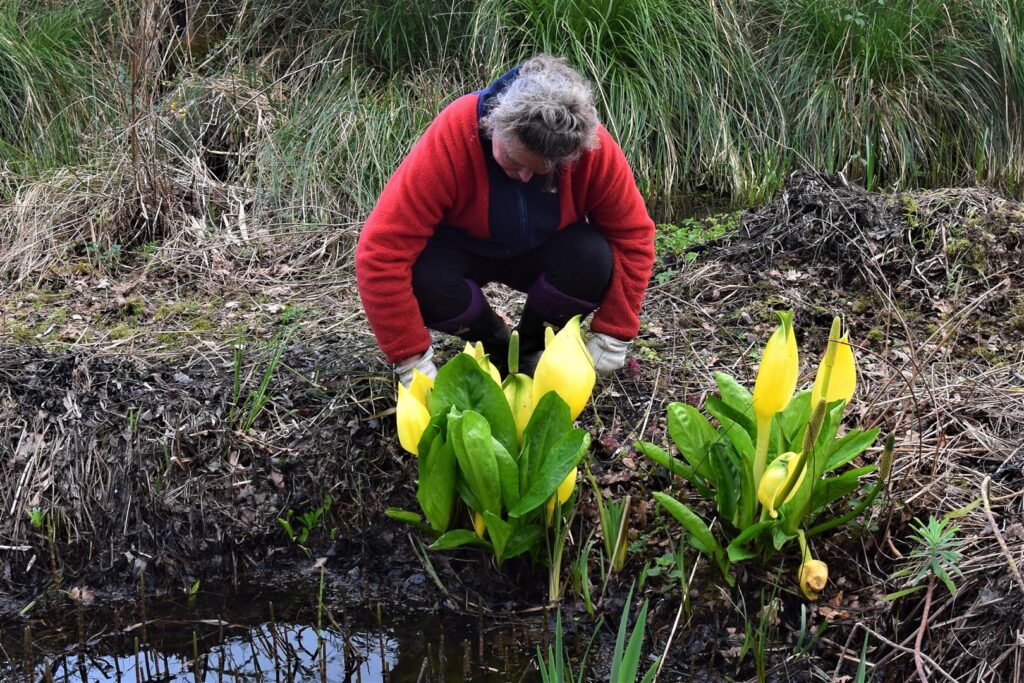
Every year at this time I feature a photo of our American skunk cabbages in bloom and they are show stoppers and although the flower lasts only days it is followed by huge paddle like leaves which can grow to a metre high and last throughout the summer . The young plants are slow to grow and take about five years to really get going and while they can grow in water I grow them here in mud at the waterside and this year I see self seeders for the first time in ten years and these I will pot up and transfer to the new water area .
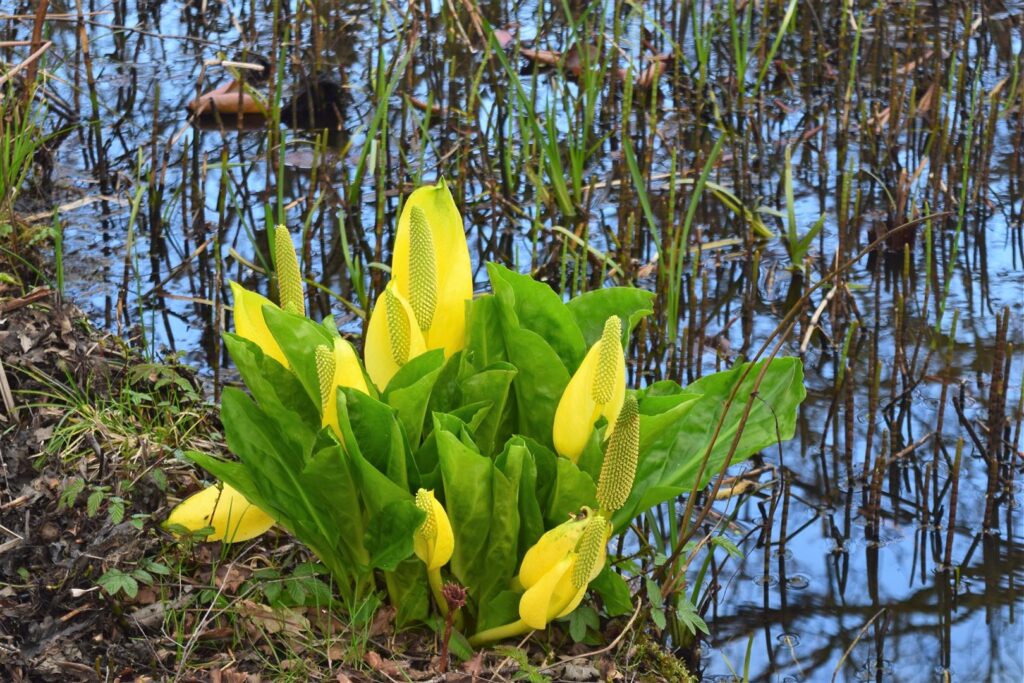


Leave a Reply